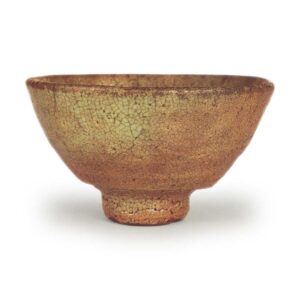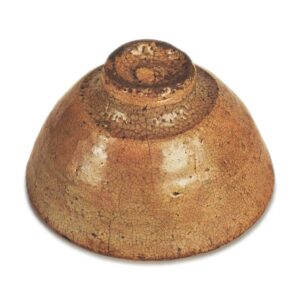

Important Cultural Property
Held by: Seikado Bunko Art Museum
Height: 8.5cm
Diameter: 14.6cm
Height of foot ring: 5.4cm
Height of lid: 1.8cm
There is a label on the paulownia wood, Shunkei lacquered inner box that says “Echigo-dono-ido”, and it is said that this name was given because it was owned by a certain Echigo governor. It is not clear who the Echigo governor was.
This is a large, solid bowl with a strong foot ring, and a dignified appearance. The clay is rough and contains a small amount of iron, and a thick, cloudy, transparent glaze is applied to it. The glaze drips and forms a double layer, and the cracks are rough where the glaze is thick, and fine where it is thin.
The clay was pulled up on the potter’s wheel, and there are four rough, thick finger marks on the body. The mouth is thick and solid, and the foot is also scraped with a single blade, creating what is commonly known as a bamboo joint foot. The tatami mat is exposed, but it is worn down so much that the marks are not clearly visible, and the outside is as it was when it was pulled off the potter’s wheel. The inside of the foot ring was also scraped with a single blade, and the center is slightly shaped like a fan.
The firing is slightly oxidized, and both the inside and outside are a loquat color, but one side is a slightly bluish half-glaze, and when viewed in strong light, it has a slightly purplish nacreous appearance. The glaze has melted well because the fire was strong and it was well-fired, and the kaaragi is also starting to melt.
The inside is deep and has five sand grains, and the center is hollowed out due to the soil coming undone. There are some large and small holes in the rim, which have been repaired with black lacquer. There are several vertical grooves of various sizes, and as mentioned in the “Chukyo Meibutsu Roku” and “Fushimiya Kakusho” (“Ware Ari” – “There is a crack”), the body is split in two and has been repaired with black lacquer.
The highlights are the imposing shape of the foot, the tone of the kaaragi (Japanese paper mulberry bark), the strong and distinct lathe marks from the body to the waist, the thick glaze that flows over the body, and the beautiful glaze tone of the slightly asymmetrical biwa-iro (loquat-colored) glaze. This is a large and imposing tea bowl, even by the standards of the famous tea bowls.
It is thought that it was originally owned by a certain Echigo governor, and then passed into the hands of the Satsumaya family, and was passed down through the Mitsui family of Rokkaku, Kyoto, during the Edo period, but was later acquired by the Iwasaki family in the Meiji era.



